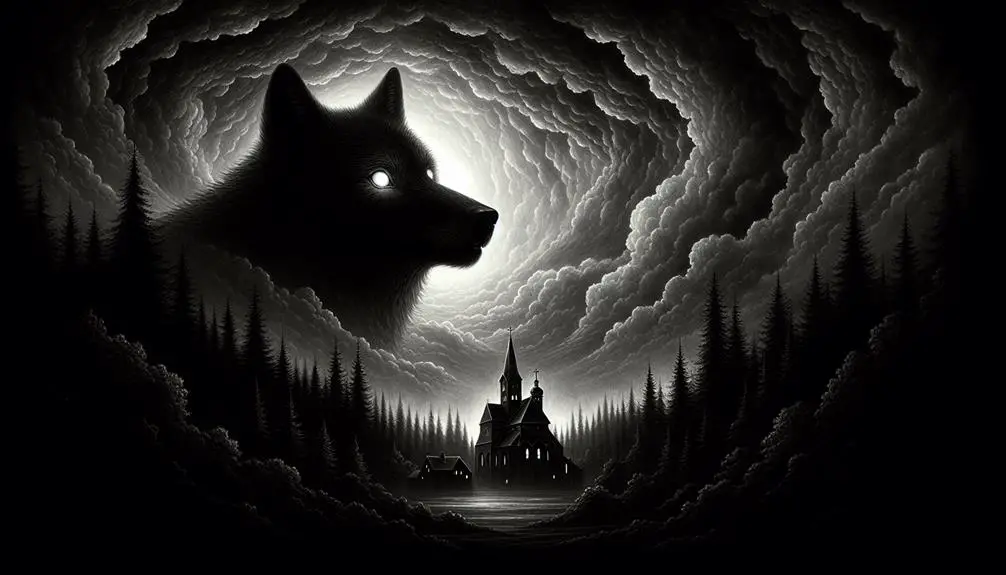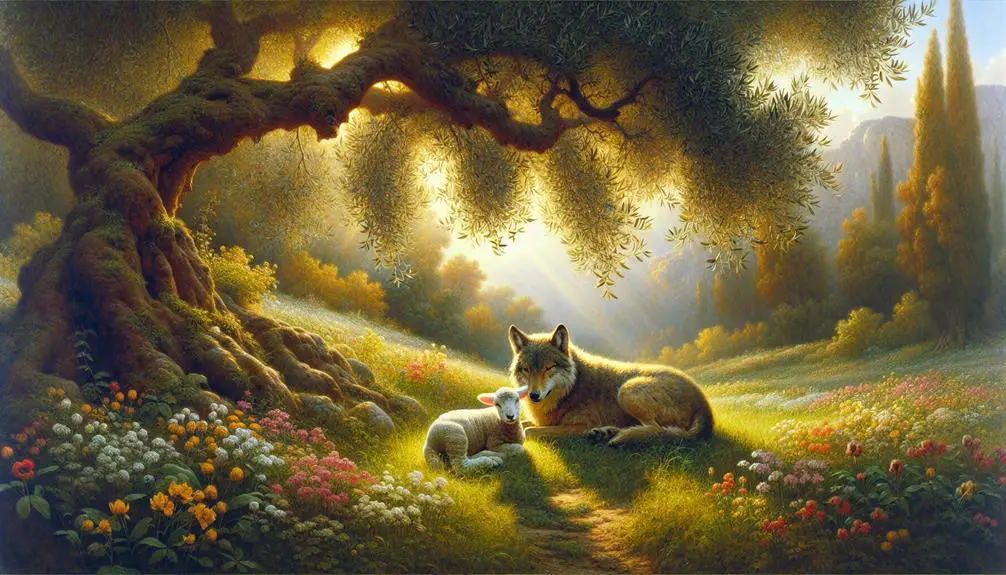Is the portrayal of wolves in the Bible truly evil, or is there more to their story? Dive in to uncover the hidden layers.

Are Wolves Evil in the Bible
You might think wolves in the Bible got a bad rap, always cast as the villains in celestial tales, lurking in the shadows, ready to pounce on the unsuspecting sheep. But is it fair to label them as purely evil?
The Bible's imagery and symbolism are rich and varied, often leaving more questions than answers. As we explore the symbolic meanings behind these creatures, we uncover a tapestry of interpretations that challenge the simplistic notion of wolves as mere symbols of malevolence.
Stick around, and you might find the discussion on wolves in the Bible reveals more about human nature than you'd expect.
Key Takeaways
- Wolves in the Bible symbolize both dangers, like deceit and aggression, and positive values like guidance and communal harmony.
- Negative representations often warn against spiritual and moral threats, highlighting the need for vigilance and faith.
- Cultural and historical contexts shape the dualistic portrayal of wolves, calling for a nuanced understanding beyond viewing them as purely evil.
- Interpretations of wolves in biblical texts evolve, reflecting shifts in cultural perceptions and encouraging a deeper analysis of their symbolism.
Wolves in Biblical Imagery

Throughout the Bible, wolves are frequently used as symbols, often embodying the dangers and moral threats that believers may face. This utilization of wolf symbolism serves to illustrate the multifaceted nature of Biblical predators, offering a rich tapestry of interpretations and insights into the text's deeper meanings. As you delve into the scriptures, you'll find that wolves aren't merely animals but are emblematic of broader concepts of deceit, aggression, and challenges to faith.
In analyzing wolf symbolism within the Biblical context, it's essential to recognize the cultural and historical significance of wolves at the time these texts were written. Wolves were common in the Middle East, often posing a direct threat to livestock and, by extension, the livelihood of the people. Their predatory nature made them a potent symbol for danger and destruction, easily understood by the contemporary audience.
This symbolic use of wolves extends beyond the literal interpretation of the animal as a predator. It encompasses the spiritual and moral deterioration that can occur within individuals and communities. The Bible often uses wolves to represent false prophets or teachers who, under the guise of sheep's clothing, seek to lead the faithful astray. This imagery warns believers of the subtlety and cunning with which spiritual dangers can present themselves.
Symbolic Meanings of Wolves
CURRENT SUBTOPIC: 'Symbolic Meanings of Wolves'
Building on the understanding of wolves as multifaceted symbols in Biblical imagery, it's crucial to explore the layers of meaning these predators carry within the scriptures. The symbolic representations of wolves in the Bible are deeply intertwined with cultural interpretations, offering a rich tapestry of insights into human nature, divine prophesy, and moral guidance.
Wolf symbolism is not monolithic; rather, it reflects a spectrum of meanings across different contexts and cultures. Within the Biblical narrative, wolves often serve as symbols with dual aspects, embodying both positive attributes and cautionary elements. These creatures are not merely background characters but are imbued with symbolic significance that resonates with the cultural and spiritual milieu of the times.
To make this analysis more relatable and enjoyable, let's look at the symbolic meanings of wolves through a concise table:
Symbolic Aspect |
Cultural Interpretation |
|---|---|
Protection |
In some cultures, wolves are seen as protectors, guiding and guarding individuals or communities. |
Community |
Wolves' pack behavior symbolizes the importance of family, loyalty, and social bonds. |
Teaching |
They represent learning and adaptation, encouraging humans to understand deeper truths about themselves and the world. |
Transformation |
Wolves symbolize change and the journey through life, reflecting personal growth and spiritual evolution. |
In analyzing wolf symbolism within the Bible, it's evident that these creatures carry a complex array of meanings. Their representation goes beyond simplistic binaries, inviting readers to delve into the nuanced layers of cultural interpretations and spiritual messages encapsulated within the scriptures.
Negative Connotations Explored

While wolves carry a spectrum of positive symbolism, they also embody several negative connotations within biblical texts, reflecting aspects of danger, betrayal, and moral decay. This dual representation highlights the complex relationship between humans and these animals, influenced heavily by cultural perceptions and the context of biblical narratives.
Wolf metaphors in the Bible often serve to illustrate the stark contrast between the perceived purity and divinity of sheep and the cunning, predatory nature of wolves. This dichotomy plays into broader cultural perceptions of good versus evil, with wolves frequently cast in the role of villains. Here's a deeper look into the negative connotations of wolves in biblical texts:
- Predators of the Innocent: Wolves are frequently depicted as threats to the safety of the flock, symbolizing the dangers that the faithful may face from false prophets and morally corrupt individuals.
- Symbols of Destruction: Their role as destroyers in various passages underlines the destructive aspects of sin and the potential for moral decay within communities.
- Agents of Betrayal: The cunning nature attributed to wolves reflects the betrayal and deceit that can arise within human relationships, warning believers to remain vigilant.
- Emblems of Spiritual Threat: Wolves metaphorically represent spiritual adversaries, emphasizing the need for spiritual awareness and adherence to divine guidance to navigate life's moral complexities.
These negative connotations serve as cautionary tales within the biblical context, offering guidance on navigating the moral and spiritual challenges of life. They underscore the importance of vigilance, purity of faith, and the constant threat posed by those who might lead the faithful astray.
Positive Representations Uncovered

Despite the negative connotations explored previously, wolves also embody positive symbolism within biblical narratives, reflecting attributes of guidance, protection, and unity. This shift in perception highlights the multifaceted character of wolves, moving beyond simplistic interpretations. In biblical texts, the imagery of wolves transforms in certain contexts to represent noble qualities that align with shepherd symbolism and flock protection.
Shepherd symbolism, deeply embedded in the biblical tradition, often evokes the idea of leadership and guidance. While shepherds protect their flocks from wolves, this relationship in the biblical metaphor transcends literal interpretation. It suggests a nuanced understanding of wolves, associating them with qualities of vigilance and communal harmony. This perspective encourages you to appreciate the complexity of biblical symbols, recognizing that entities often embody both positive and negative aspects.
Furthermore, the concept of flock protection, while typically highlighting the shepherd's role, can also extend to how wolves operate within their packs. Their social structure emphasizes unity and collective effort in safeguarding the members. This aspect resonates with biblical themes of community and mutual care, suggesting that wolves' behavior can mirror positive biblical values of protection and solidarity.
Reevaluating Biblical Wolves

Reevaluating biblical wolves necessitates a deeper examination of their dualistic representation, urging you to consider their symbolic significance beyond traditional interpretations. This exploration is critical in understanding how cultural perceptions and interpretation evolution have shaped our view of wolves in biblical contexts.
Here are four key aspects to consider:
- Historical Context: Understanding the historical and environmental context in which biblical texts were written is crucial. Wolves were common in ancient times, often seen as threats to livestock and, by extension, human livelihood. This reality influenced their negative portrayal.
- Symbolic Layers: Wolves in the Bible carry layers of symbolism. Beyond the literal interpretation of wolves as dangerous creatures, they symbolize broader themes such as greed, destruction, and deceit. However, this symbolism can evolve with cultural shifts, prompting a reevaluation of their role.
- Cultural Perceptions: Cultural perceptions of wolves have undergone significant changes over centuries. In contemporary times, increased awareness of ecological balance and wildlife conservation has led to a more nuanced understanding of wolves, influencing their interpretation in biblical texts.
- Interpretation Evolution: The evolution of biblical interpretation plays a pivotal role in reevaluating wolves. Modern biblical scholarship encourages examining texts through various lenses, including literary, historical, and cultural contexts. This multidimensional approach allows for a more balanced understanding of wolves' symbolic significance.
Frequently Asked Questions
How Do Wolves Compare to Other Animals Mentioned in the Bible in Terms of Their Moral Symbolism?
In comparing wolves to other animals in the Bible, you'll find their moral symbolism contrasts sharply with the innocence of lamb symbolism and the deceit tied to the serpent metaphor.
While lambs represent purity and sacrifice, serpents often symbolize temptation and evil.
Wolves, however, embody both threat and cunning, highlighting a complex nature.
This complexity allows you to explore deeper themes of morality and survival in biblical narratives.
Have There Been Any Significant Changes in How Wolves Are Viewed in Modern Interpretations of the Bible Compared to Ancient Texts?
In your exploration of modern biblical perspectives, you'll find that translation evolution and interpretation discrepancies have nuanced how wolves are perceived.
Initially cast in shadowy hues, these creatures' symbolic roles have shifted through scholarly analysis and cultural reinterpretation. This change underscores the fluidity of scriptural understanding over centuries.
While ancient texts may offer a stark portrayal, contemporary interpretations invite a more layered, complex view that reflects our evolving relationship with these beings and their symbolic significance.
Are There Specific Biblical Stories or Parables Where Wolves Play a Central Role Not Covered in Traditional Discussions?
You're exploring specific biblical stories or parables where wolves are central, beyond traditional discussions. It's crucial to dive into wolf metaphors and shepherd narratives, which often carry deep symbolic meanings.
These stories don't just depict physical realities but also embody spiritual and moral lessons. Analyzing them, you'll uncover layers of interpretation that reveal how these narratives have shaped perceptions and teachings, offering a richer understanding of their roles and symbolism.
How Do Cultural Perceptions of Wolves Outside the Bible Influence Their Portrayal Within It?
You're stepping into a realm where wolf mythology and cultural fears intertwine, casting long shadows over perceptions. These narratives, steeped in ancient lore, inevitably color the portrayal of wolves, even within biblical texts.
What Do Biblical Scholars Say About the Direct Impact of Wolves' Characteristics on Their Symbolic Representation in the Bible?
You're delving into what biblical scholars reveal about wolves' characteristics and their symbolic representation in scripture. They argue that wolf metaphors and predator imagery aren't arbitrary; these elements stem directly from the animals' real-life behaviors and the societal perceptions of them during biblical times.
This analysis points to a deep, contextual understanding of the metaphorical use of wolves, showing a direct link between their natural attributes and their narrative roles in the Bible.
Conclusion
In sum, wolves in the Bible wear a coat of many colors, not just the black of villainy. They're symbolic creatures, embodying both the shadows of danger and the light of guidance.
While often cast in a negative light, a deeper dive reveals a more nuanced portrayal. Like two sides of the same coin, wolves represent both the perils and the potentials inherent in nature and humanity.
Thus, reevaluating biblical wolves invites us to embrace complexity over simplicity in our interpretations.



Sign up